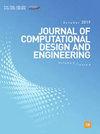基于改进型海马优化器的全局优化和工程问题解决新方法
IF 6.1
2区 工程技术
Q1 COMPUTER SCIENCE, INTERDISCIPLINARY APPLICATIONS
引用次数: 0
摘要
海马优化算法(SHO)是一种值得关注的元启发式算法,它模仿了海马的各种智能行为,包括进食模式、雄性繁殖策略和复杂的运动模式。为了模仿海马细致入微的运动方式,SHO 将对数螺旋方程和列维飞行整合在一起,有效地将步长较大的随机运动和精细的局部利用结合在一起。此外,布朗运动的利用还有助于对搜索空间进行更全面的探索。本研究介绍了一种名为 mSHO 的 SHO 算法的稳健和高性能变体。这种改进主要集中在增强 SHO 的开发能力上,方法是用一种创新的局部搜索策略取代其原始方法,该策略包括三个不同的步骤:基于邻域的局部搜索、基于非邻域的全局搜索以及涉及现有搜索区域环绕的方法。这些技术提高了 mSHO 算法的搜索能力,使其能够在搜索空间中导航,并高效地收敛到最优解。为了评估 mSHO 算法的功效,我们对 CEC2020 基准函数和九个不同的工程问题进行了全面评估。与九种元启发式算法进行了细致的比较,以验证所取得的成果。统计检验(包括 Wilcoxon 秩和检验和 Friedman 检验)被恰当地应用于识别比较算法之间值得注意的差异。实证研究结果一致强调了 mSHO 在各种基准函数中的卓越性能,从而增强了其解决复杂优化问题的能力。此外,即使优化挑战的维度不断扩大,mSHO 的鲁棒性也能经久不衰,这表明它在驾驭复杂搜索空间方面具有坚定不移的功效。综合结果明确地证明了 mSHO 方法的优越性和高效性,是解决一系列优化难题的典范工具。结果表明,所提出的 mSHO 算法在 CEC 的 2020 个测试函数中的总排名为 1。相比之下,mSHO 在工程问题上取得了最佳值,在压力容器设计中分别记录了 0.012665、2993.634、0.01266、1.724967、263.8915、0.032255、58507.14、1.339956 和 0.分别为压力容器设计、减速机设计、拉伸/压缩弹簧、焊接梁设计、三杆桁架工程设计、工业制冷系统、多产品配料厂、悬臂梁问题、多盘离合器制动器问题。mSHO 的源代码可在 https://www.mathworks.com/matlabcentral/fileexchange/135882-improved-sea-horse-algorithm 公开获取。本文章由计算机程序翻译,如有差异,请以英文原文为准。
A new approach for solving global optimization and engineering problems based on modified Sea Horse Optimizer
Sea Horse Optimizer (SHO) is a noteworthy metaheuristic algorithm that emulates various intelligent behaviors exhibited by sea horses, encompassing feeding patterns, male reproductive strategies, and intricate movement patterns. To mimic the nuanced locomotion of sea horses, SHO integrates the logarithmic helical equation and Levy flight, effectively incorporating both random movements with substantial step sizes and refined local exploitation. Additionally, the utilization of Brownian motion facilitates a more comprehensive exploration of the search space. This study introduces a robust and high-performance variant of the SHO algorithm named mSHO. The enhancement primarily focuses on bolstering SHO's exploitation capabilities by replacing its original method with an innovative local search strategy encompassing three distinct steps: a neighborhood-based local search, a global non-neighbor-based search, and a method involving circumnavigation of the existing search region. These techniques improve mSHO algorithm's search capabilities, allowing it to navigate the search space and converge toward optimal solutions efficiently. To evaluate the efficacy of the mSHO algorithm, comprehensive assessments are conducted across both the CEC2020 benchmark functions and nine distinct engineering problems. A meticulous comparison is drawn against nine metaheuristic algorithms to validate the achieved outcomes. Statistical tests, including Wilcoxon's rank-sum and Friedman's tests, are aptly applied to discern noteworthy differences among the compared algorithms. Empirical findings consistently underscore the exceptional performance of mSHO across diverse benchmark functions, reinforcing its prowess in solving complex optimization problems. Furthermore, the robustness of mSHO endures even as the dimensions of optimization challenges expand, signifying its unwavering efficacy in navigating complex search spaces. The comprehensive results distinctly establish the supremacy and efficiency of the mSHO method as an exemplary tool for tackling an array of optimization quandaries. The results show that the proposed mSHO algorithm has a total rank of 1 for CEC’2020 test functions. In contrast, the mSHO achieved the best value for the engineering problems, recording a value of 0.012665, 2993.634, 0.01266, 1.724967, 263.8915, 0.032255, 58507.14, 1.339956, and 0.23524 for the pressure vessel design, speed reducer design, tension/compression spring, welded beam design, three-bar truss engineering design, industrial refrigeration system, multi-Product batch plant, cantilever beam problem, multiple disc clutch brake problems, respectively. Source codes of mSHO are publicly available at https://www.mathworks.com/matlabcentral/fileexchange/135882-improved-sea-horse-algorithm.
求助全文
通过发布文献求助,成功后即可免费获取论文全文。
去求助
来源期刊

Journal of Computational Design and Engineering
Computer Science-Human-Computer Interaction
CiteScore
7.70
自引率
20.40%
发文量
125
期刊介绍:
Journal of Computational Design and Engineering is an international journal that aims to provide academia and industry with a venue for rapid publication of research papers reporting innovative computational methods and applications to achieve a major breakthrough, practical improvements, and bold new research directions within a wide range of design and engineering:
• Theory and its progress in computational advancement for design and engineering
• Development of computational framework to support large scale design and engineering
• Interaction issues among human, designed artifacts, and systems
• Knowledge-intensive technologies for intelligent and sustainable systems
• Emerging technology and convergence of technology fields presented with convincing design examples
• Educational issues for academia, practitioners, and future generation
• Proposal on new research directions as well as survey and retrospectives on mature field.
 求助内容:
求助内容: 应助结果提醒方式:
应助结果提醒方式:


